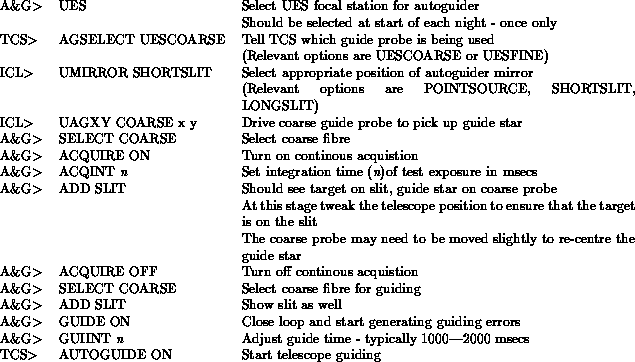





Previous: Guiding
Up: Guiding
Next: Autoguiding using offset guide stars-found using TV
Previous Page: Guiding
Next Page: Autoguiding using offset guide stars-found using TV






Previous: Guiding
Up: Guiding
Next: Autoguiding using offset guide stars-found using TV
Previous Page: Guiding
Next Page: Autoguiding using offset guide stars-found using TV
The principal difference between offset guiding at Cassegrain and with UES is the much smaller field visible through the Nasymth A&G guide probes. It is essential to have some means of predicting where to put the guide probes in order to pick up a guide star. The Guide Star Server is now available and provides a useful means of quickly locating guide stars.
The normal procedure for offset guiding is to use the Guide Star Server (GSS) to locate a guide star. Documention for the GSS is located in the WHT Control Room. The GSS is presently run on the ING VAX/VMS cluster to which you should have a GUEST account. To set up the symbols needed to run the GSS, execute the command procedure:
@DISK$USER3:[GSS]GSS_INIT
Then type GSS to start the software, which will respond with a GSS> prompt. A simple GSS session follows:

This finds upto the 10 brightest guide stars available for the WHT UES focus at the specified position for rotator position angle n (where the rotator position angle is the rotator position on the sky-often set to the parallactic angle for observations of point sources). The position and probe coordinates for the guide star are given in OUTPUT.GS, which is the default output file name. . the required slitlength. The larger the field required at the slit, the smaller the field available for finding guide stars; this is a critical tradeoff to consider, particularly out of the galactic plane, where the number of guide stars available is small. Table 20 summarises the unvignetted and partially vignetted field provided by each of the options. Figure 5 shows plots of the vignetting along the slit.
Having got light from the guide star down the guide probe, the procedure to follow is almost identical to that for guiding at Cass. Take a test exposure to locate potential guide stars, start generating guide errors, and tell the telescope to start correcting for the guide errors. It is possible to vary the autoguider integration time, and also to select from a range of autoguider filters.
The detailed procedure is as follows. This example assumes observations using a short slit, and autoguiding using the coarse guide probe. Commands with the ICL prompt are issued from the system computer, and commands with the TCS prompt are issued from the Telescope Control System, whilst commands with the A&G promopt are given at the autoguider terminal.

Before moving to a different target , type:

Note that it is not necessary to use the PROBE command to tell the TCS the guide probe coordinates. This is necessary at Cassegrain because the autoguider orientation is a function of the probe coordinates; this is not the case at Nasymth. Further the A&G FIELD command is not needed at UES.
Ful details on the use of the autoguider can be found in
the WHT Autoguider User Manual.
It is planned to eventually
implement all commands presently issued at the A&G console at the ICL
console.





